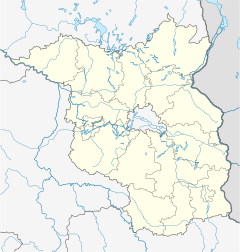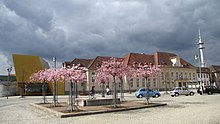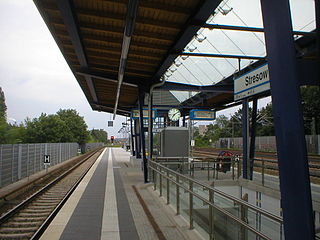
Stresow is a railway station in the Spandau district of Berlin, named after the Stresow neighbourhood east of the Havel river. It is served by the S-Bahn lines S3 and S9.

The Berlin–Halle railway, sometimes called the Anhalt railway, is a twin-track, electrified main line found in the German city and state of Berlin, and the states of Brandenburg and Sachsen-Anhalt. The railway was originally built and managed by the Berlin-Anhaltische Eisenbahn-Gesellschaft.

Wustermark station is a railway station in the town of Wustermark in the Havelland region of the German state of Brandenburg, to the west of Berlin. The station is located on the Berlin–Lehrte railway and is connected with the Jüterbog–Nauen railway, part of which became part of the Berlin outer ring in the 1950s. It is classified by Deutsche Bahn as a category 5 station.

Rathenow is a railway station on the Berlin–Lehrte railway located in Rathenow, in the Havelland, Germany. It is used by about 3,300 passengers daily.

The Jüterbog–Röderau railway is an electrified main line in the German states of Brandenburg, Saxony-Anhalt and Saxony. It runs from Jüterbog via Falkenberg (Elster) to Röderau, near Riesa. There it ends in a triangular junction with the Leipzig–Dresden railway, connecting to Riesa and Dresden. The Jüterbog–Falkenberg section consists of a single track; the Falkenberg–Riesa section has two tracks. It was opened in 1848 and is one of the oldest lines in Germany.

Cottbus Hauptbahnhof (German) or Chóśebuz głowne dwórnišćo is one of the main railway stations of the German state of Brandenburg. It was called Cottbus station until 9 December 2018. It is located just south of central Cottbus. It is classified by Deutsche Bahn as a category 2 station.
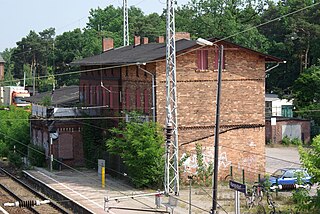
Rangsdorf station is a station in the locality of Rangsdorf in the district of Teltow-Fläming in the German state of Brandenburg. It is located at kilometre 24.3 of Berlin–Dresden railway. Until 1919, the western part of the station was served by the Royal Prussian Military Railway.

Teltow station is located in the town of Teltow on the Anhalt Railway south of Berlin and was opened in 1901. Since then, the station has been repeatedly remodelled. The station served regional passenger and freight traffic and was the terminus of a Berlin S-Bahn service from 1950 to 1961. The direct connection to Berlin was lost with the construction of the Berlin Wall in 1961. It was restored in 2006.

Großbeeren station is a station in the town of Großbeeren on the Anhalt Railway south of Berlin. The station, which was inaugurated in 1841, is one of the oldest railway stations in the state of Brandenburg. The now disused station building is a listed building.

Ludwigsfelde station is located in the town of Ludwigsfelde on the Anhalt Railway south of Berlin and is one of the oldest railway stations in the German state Brandenburg. The station building, which was built around 1880, is a listed building and is the second oldest building in the town. It now houses a museum. Several houses in the railway station area are also listed buildings.

Karstädt station is the station of Karstädt in the German state of Brandenburg. It lies on the Berlin–Hamburg Railway and was opened for freight in 1853 and for passengers in 1859. The Karstädt station of the former Westprignitz District Ring Railway was nearby and was served by passenger services from 1911 to 1975 and by freight traffic until the beginning of the 1990s. The state station's Neoclassical entrance building along with a second building, its goods shed and the paving of the forecourt have heritage protection.

Glöwen station is the station of the town of Glöwen, which is in the municipality of Plattenburg and the German state of Brandenburg. It lies on the Berlin–Hamburg Railway and was opened in 1846. The Glöwen–Havelberg railway branched at the station from 1890 to 1971. The former Light Railway of the District of West and East Prignitz from Viesecke, a small town now in the municipality of Plattenburg, ended in Glöwen from 1900 to 1967. The Neoclassical entrance, which was built at the same time as the line, has heritage protection.
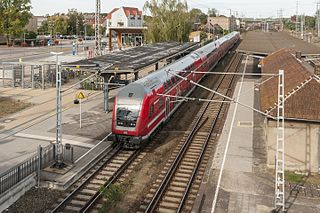
Falkenberg (Elster) station is one of the biggest stations in the German state of Brandenburg. It is located in the town of Falkenberg/Elster in the south of the state. It is classified by Deutsche Bahn as a category 3 station. Railways run in seven directions from the station. It is a two-level interchange station, built where several routes interconnect. There is a large marshalling yard connecting to both the upper and the lower parts of the station. At times Falkenberg was the fifth largest marshalling yard in East Germany (GDR). Only part of these tracks have been in use since the 1990s.

Roßlau (Elbe) station is a passenger station and freight yard in the district of Roßlau of the city of Dessau in the German state of Saxony-Anhalt.

Guben station is a station of Guben in the German state of Brandenburg. It is at the junction of lines from Berlin to Wrocław via Frankfurt (Oder) and from Cottbus to Zbąszynek. The station building is surrounded by the tracks. Only the route between Frankfurt (Oder)–Cottbus is used by passenger services, while the line towards Zbąszynek is used for freight traffic.

Fürstenwalde (Spree) station is the station of the city of Fürstenwalde/Spree in the German state of Brandenburg. It was opened on 23 October 1842 on the Berlin-Frankfurt railway. The station was then about one kilometre north of the town on Müncheberger Chaussee. The station building still exists and is one of the oldest in Germany.
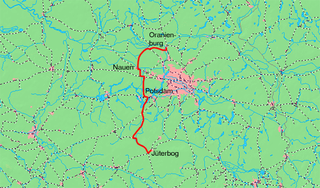
The Jüterbog–Nauen railway is a line that runs to the west of Berlin through the German state of Brandenburg. It runs from Jüterbog via Treuenbrietzen, Beelitz, Potsdam, Wustermark to Nauen. The line is a part of the Bypass Railway (Umgehungsbahn), which was primarily designed to relieve congestion on the railways in Berlin. The Wustermark–Nauen section has been closed, the Golm–Priort section is now a part of the Berlin outer ring and has been rebuilt as a double-track main line.

Potsdam Pirschheide station is a station on the Berlin outer ring. It was opened in 1958 as Potsdam Süd (south) station and was called Potsdam Hauptbahnhof from 1961 to 1993. In this period it was the most important station on the outer ring after Berlin Schönefeld Flughafen station.
The Royal Prussian Military Railway, also called the Königliche Militär-Eisenbahn, was a Prussian state railway, operated by the army, between Schöneberg and Kummersdorf, later extended to Jüterbog.

Jüterbog station is a station in the town of Jüterbog in the German state of Brandenburg. It was opened in 1841, which makes it one of the oldest railway stations in Brandenburg. The Jüterbog–Röderau railway has branched off the Berlin–Halle railway (Anhalterbahn) at the station since 1848. Its importance grew with the opening of further railway lines. Some of these lines have now been closed.

